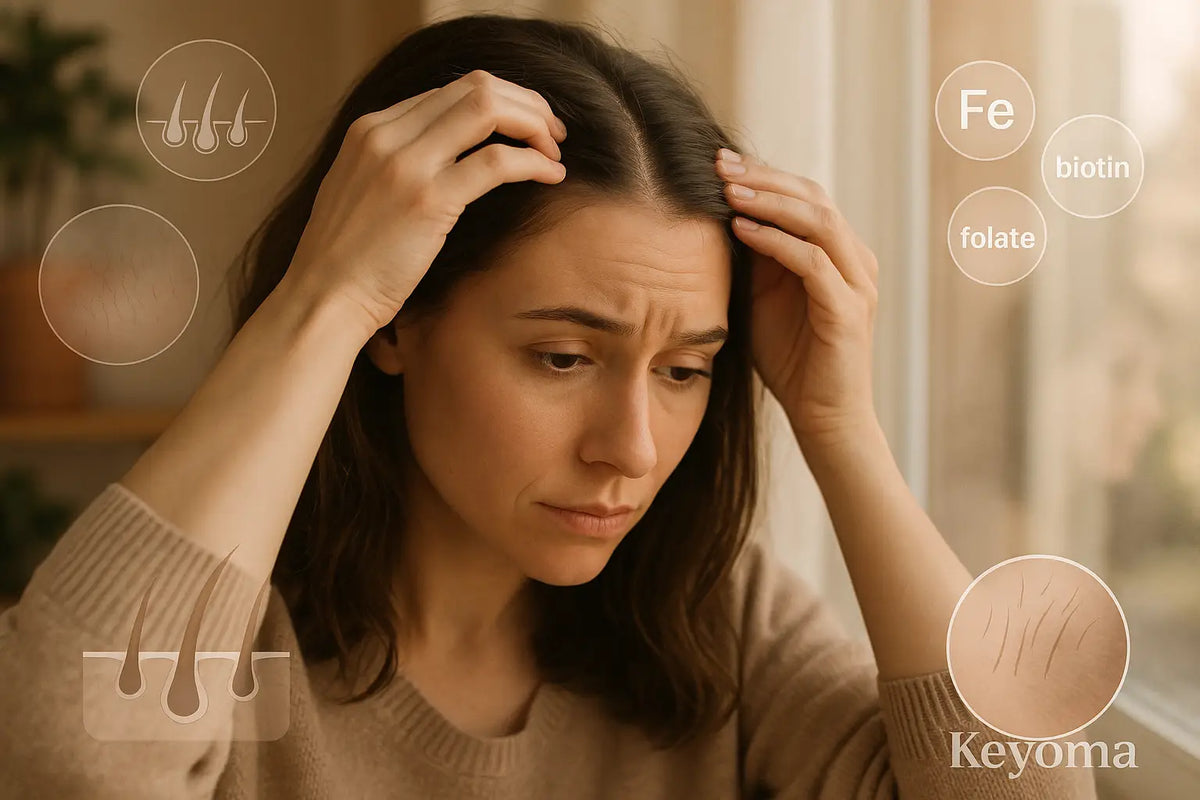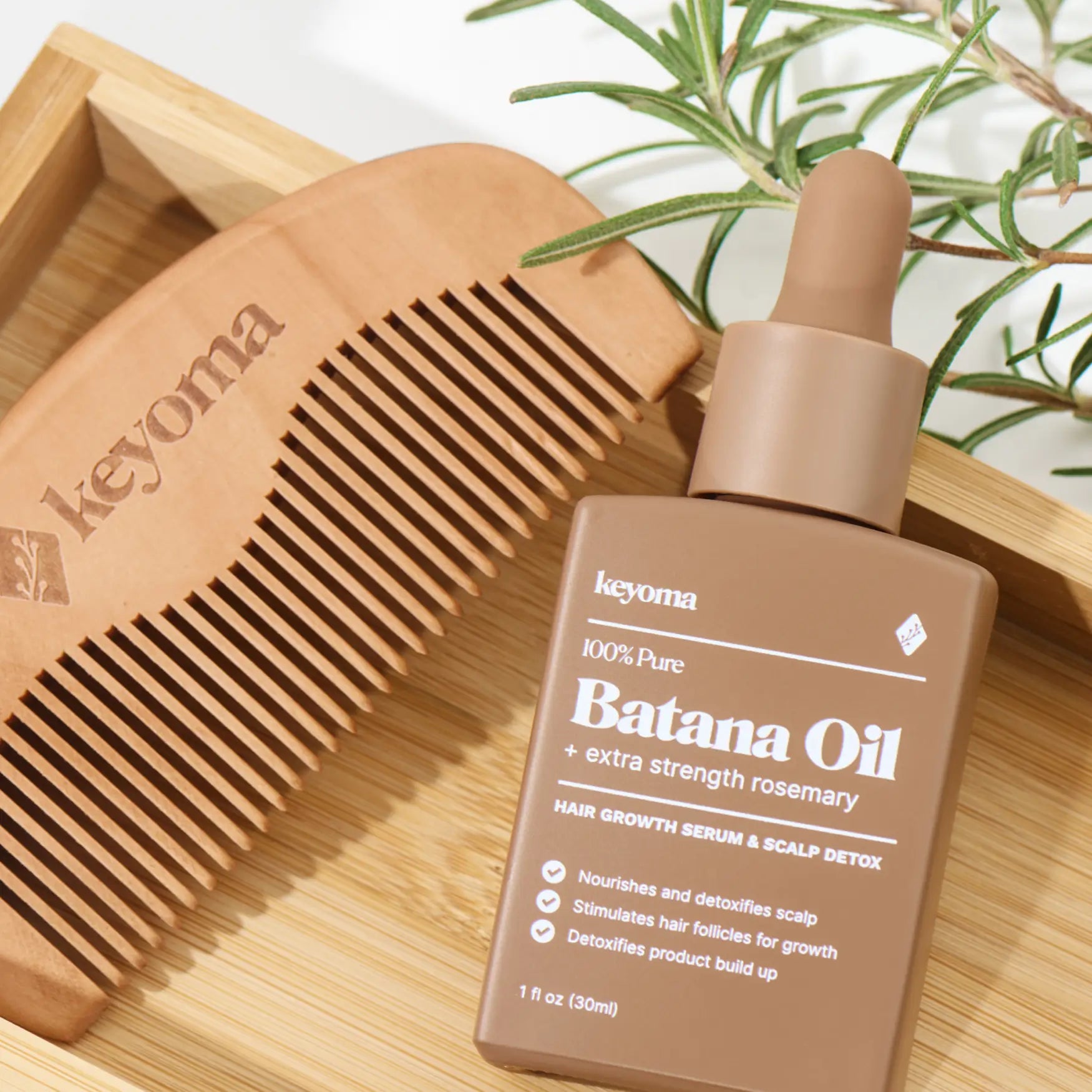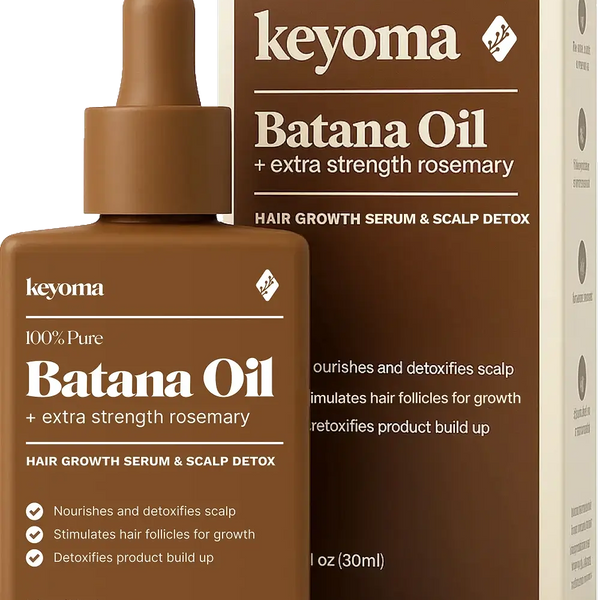In this article
Most people shed 50 to 100 hairs each day. Losing more than that may signal excess shedding, which often leads to overall hair thinning.
Unlike full hair loss, thinning doesn’t always cause bald spots. Instead, it makes areas of your scalp look less dense.
Thinning usually develops slowly, giving you a chance to identify the triggers and choose the right ways to treat it.
Why Your Hair Is Thinning
Two main conditions cause most hair loss linked to aging.
The most common is androgenetic alopecia, also known as male- or female-pattern hair loss. Thinning hair is usually the first sign. Hair follicles shrink, making strands thinner. Some follicles stop growing hair entirely, according to experts.
This form of hair loss often results from genetics or age-related hormone shifts. It appears slowly and follows patterns that differ between men and women.
In men, the hairline usually recedes, or thinning starts at the temples or crown. In women, it often affects the entire scalp or specific areas like the part line, temples, or front of the scalp. But women with androgenetic alopecia typically don’t go fully bald like men.
Another frequent cause of hair shedding is telogen effluvium. This type of loss happens fast and usually follows emotional or physical stress. Experts explain it can occur after a high fever, infection, or surgery. It may also result from health problems or new medications.
Explore natural hair regrowth options
Common Causes of Thinning Hair
Thinning hair often results from daily routines, inherited traits, or a mix of both. Some health conditions can also trigger hair to thin.
Common lifestyle factors include:
-
Using strong chemical products: Items like extra-hold sprays and gels can dry out hair and irritate the scalp.
-
Missing key nutrients: Lacking iron, folate, and other essential minerals limits your body's ability to grow hair effectively.
-
Overprocessing your hair: Frequent coloring, relaxing, or perming can weaken strands and damage follicles.
-
Wearing tight styles: Constantly pulling your hair into ponytails, buns, or braids puts pressure on the roots and may lead to breakage and thinning over time.
-
Living with long-term stress: Ongoing stress increases cortisol levels, which can lead to telogen effluvium—a condition where hair sheds and follicles pause new growth.
Genetics or hidden health issues can also cause thinning hair. You might notice hair loss if you:
-
Lack enough vitamin D
-
Gave birth recently
-
Stopped using birth control pills
-
Are experiencing hormone shifts
-
Lost a large amount of weight quickly
-
Have low levels of nutrients like riboflavin, selenium, or zinc
-
Are undergoing treatment for an autoimmune condition
-
Have a weakened immune system
-
Have a skin condition or infection
Less commonly, thinning hair may be caused by:
-
Frequently tugging on your hair
-
Recently had a severe fever
-
Struggling with disordered eating
12 Thinning Hair Treatments You Can Try at Home

You may manage some hair thinning at home. Explore these 12 approaches, but check with a healthcare provider before starting.
1. Try a Scalp Massage
Scalp massage might be the most budget-friendly way to support thicker hair. It’s free and safe when done properly.
During washing, use your fingertips to gently press and move across your scalp to boost circulation. You can also use a handheld scalp tool to help clear away dead skin. Still, limited research supports its ability to stop hair thinning.
2. Use Essential Oils for Hair Support
Essential oils come from specific plants and are commonly used in aromatherapy and natural healing practices. Some individuals with pattern hair loss report positive results from using lavender oil.
A 2016 animal study supports this claim, but researchers still need human trials to verify its effects. People often mix lavender with other oils like rosemary, thyme, or batana, a traditional oil used to strengthen hair and nourish the scalp.
That said, there’s limited proof that essential oils can treat bald spots or thinning. If you choose to try them, always mix the essential oil with a carrier like coconut or jojoba oil. Apply a small amount to your arm first and wait 24 hours. Signs like redness, irritation, swelling, or a rash may suggest an allergic reaction.
Discover the benefits of batana oil
3. Use a Shampoo Made for Thinning Hair
Anti-thinning shampoo helps in two main ways. It adds volume to make hair appear fuller, which benefits those with fine or thinning strands.
These shampoos also include nutrients and amino acids that support scalp health. For the best outcome, follow the usage instructions closely.
You can also talk to a healthcare provider about medicated shampoo. Some brands offer prescription options through online services.
4. Add Multivitamins to Your Routine
Strong hair depends on overall physical health. When someone is undernourished or has an eating disorder, hair follicles may stop producing new strands. A blood test can check for nutrient shortages.
If your levels are low, a doctor may suggest taking a daily multivitamin. Hair growth relies on nutrients like iron, folate, and zinc to stay thick and resilient. Choose supplements for men or women that include these ingredients.
Still, avoid taking extra vitamins if your diet already provides what you need. No evidence shows that excess nutrients can fix thinning, and too much of some vitamins might cause harm.
5. Take Folic Acid Supplements
Folic acid, a form of vitamin B, supports the creation of new cells. Some research links low folate levels to certain forms of hair loss. However, like with multivitamins, there’s limited proof that folic acid alone thickens your hair.
6. Consider Biotin for Hair Strength
Biotin, also known as vitamin B7, is a water-soluble vitamin found in foods like nuts, lentils, and liver.
If you follow a well-rounded diet, you probably get enough biotin. Still, biotin supplements have become popular, partly due to marketing claims about increased energy and improved hair growth.
Biotin does support enzyme activity in the body, but studies show little proof it helps with hair thinning.
Avoid taking biotin alongside vitamin B5, as they can interfere with each other’s absorption and reduce effectiveness.
7. Eat More Omega-3 and Omega-6
Omega-3 and omega-6 are essential fats because your body can’t produce them on its own.
Omega-3 helps reduce inflammation, which plays a role in many health problems. Some studies suggest a possible connection between inflammation and early hair thinning. You can find omega-3s in fish and certain seeds. Still, a 2022 study noted that fish oil omega-3s might relate to specific kinds of hair loss.
Omega-6 supports skin function and may improve scalp health. Plant oils are the main source of omega-6, but recent studies show that omega-6 supplements might carry some health concerns.
Always talk to a healthcare provider before starting new supplements.
8. Use Minoxidil if Recommended
Minoxidil, commonly sold under the name Rogaine, is an FDA-approved treatment for hair loss available without a prescription.
When used twice daily on the scalp, minoxidil may slowly increase hair density in thinning areas. It comes in both foam and liquid forms, depending on your preference. Doctors can also prescribe it in pill form.
Visible changes can take up to 16 weeks. To get results, you need to apply it regularly.
Some people may experience scalp irritation or unwanted facial and neck hair growth as side effects.
9. Ask About Spironolactone
Doctors sometimes prescribe spironolactone (brand name Aldactone) to treat thinning hair linked to high aldosterone levels (hyperaldosteronism). Although originally a diuretic used for conditions like high blood pressure or fluid retention, it also blocks androgen activity.
In women, this medication may help manage hair thinning and loss caused by hormone shifts.
10. Ask About Finasteride
Finasteride (sold as Propecia) is a prescription drug used to treat hair loss. Men typically take it as a daily tablet.
Anyone who is pregnant or may become pregnant should avoid this medication because it can cause serious complications during pregnancy. Still, research shows that postmenopausal women often respond well to finasteride, and doctors commonly recommend it in those cases.
11. Learn When Corticosteroids Are Used
Doctors prescribe corticosteroids to treat health issues caused by inflammation. In some cases, inflammatory disorders lead to symptoms like sudden hair shedding.
Alopecia areata is one such condition—an autoimmune disorder where the immune system attacks hair follicles, resulting in patchy, mild, or severe thinning.
In these situations, corticosteroids may help by targeting and reducing inflammation at the follicle level. Based on how much hair you've lost, a dermatologist may apply the medication to your scalp or inject it every 4 to 6 weeks.
12. Try Laser Therapy at Home
Skin specialists, including dermatologists, often use laser therapy to treat hair loss. The FDA has approved certain devices for home use.
At-home laser treatments may support hair regrowth and improve thickness, though results usually take a few months to appear.
The main downside is the high price. Many devices cost hundreds of dollars, and not all deliver results. Talk to a doctor before spending on these tools.
Support Thinning Hair Naturally With Keyoma Treatments
Understand what's causing your hair thinning before jumping to advanced treatments. Start with gentler options like scalp massage or nourishing oils such as batana, which support circulation and scalp health. You can also explore changes to your diet, manage stress, and consider natural supplements to fill nutrient gaps.
If these approaches don’t help over time, talk to a doctor to rule out underlying conditions and discuss stronger treatments like minoxidil, prescription medications, or clinical therapies. Choosing the right path starts with understanding your hair’s needs.
Featured Product
100% Pure Batana Oil + Rosemary









